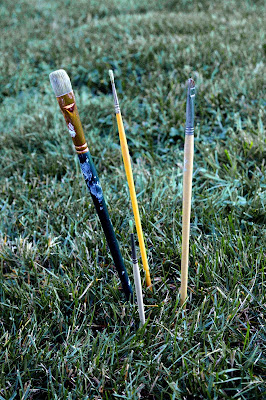 I would like to make some art tonight,... or is it that I feel I need to make art tonight. I have a deadline tonight for submitting work to a fundraiser, I need to complete a flower-painting-of-the-month in the next five days, I have a backhall that is under construction, a kitchen full of tomatoes that need to be canned, statements for an upcoming show that need to be layed-out and printed, a couple of videos to download, five new pages to create on my new website (I hope to unveil in a month), a new book cover to design and a few new projects that I want to be working on.
I would like to make some art tonight,... or is it that I feel I need to make art tonight. I have a deadline tonight for submitting work to a fundraiser, I need to complete a flower-painting-of-the-month in the next five days, I have a backhall that is under construction, a kitchen full of tomatoes that need to be canned, statements for an upcoming show that need to be layed-out and printed, a couple of videos to download, five new pages to create on my new website (I hope to unveil in a month), a new book cover to design and a few new projects that I want to be working on.
I just spent an hour and a half downloading pictures from Mallard Island and uploading some of them to a Facebook page. Some of the pictures are here in this entry.
 I stopped by The Grand Hand Gallery today to check in on the current exhibit with my work. I worked 8.5 hours today at my day job and am now creating this blog entry.
I stopped by The Grand Hand Gallery today to check in on the current exhibit with my work. I worked 8.5 hours today at my day job and am now creating this blog entry.The choices are so many and the energy is so low. A beer and a good friend seem to be the most appropriate and wished for activity.
Although I am very tired, over-burdened and wondering how to
 squeeze in any kind of creative activity, what keeps going through my mind is Claire and the idea that this planet, earth, is almost dead. Not dead to it's self, but dead to people. The environment we have created has become toxic to us and many other living things. Claire believes it is already beyond the point of no return. She doesn't believe the planet will die. She believes that we will die. We are killing ourselves through our greed and fears. Isn't it kinda absurd that some of our earliest writings recognize this weakness in ourselves and yet we haven't learned anything in 10,000 years? We have prophecized our own doom, we have laid out how we would bring it about, and yet, 4,000 generations later, we are no longer on the doorstep but have confidently and arrogantly walked through the doorway and into the end. It saddens me greatly. We are the sons of Cain.
squeeze in any kind of creative activity, what keeps going through my mind is Claire and the idea that this planet, earth, is almost dead. Not dead to it's self, but dead to people. The environment we have created has become toxic to us and many other living things. Claire believes it is already beyond the point of no return. She doesn't believe the planet will die. She believes that we will die. We are killing ourselves through our greed and fears. Isn't it kinda absurd that some of our earliest writings recognize this weakness in ourselves and yet we haven't learned anything in 10,000 years? We have prophecized our own doom, we have laid out how we would bring it about, and yet, 4,000 generations later, we are no longer on the doorstep but have confidently and arrogantly walked through the doorway and into the end. It saddens me greatly. We are the sons of Cain.Anyone for some ping-pong?








